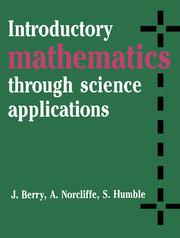Book contents
- Frontmatter
- Contents
- Preface
- 1 Basic functions
- 2 Functions for science 1: the exponential function
- 3 Functions for science 2: trigonometric functions
- 4 Functions for science 3: inverse functions
- 5 Other functions of science
- 6 Differentiation 1: rates of change
- 7 Differentiation 2: stationary points
- 8 Differentiation 3: approximation of functions
- 9 Integration 1: introduction and standard forms
- 10 Integration 2: techniques of integration
- 11 Integration 3: further techniques
- 12 First-order ordinary differential equations
- 13 Second-order ordinary differential equations
- 14 Statistics 1: frequency distributions and associated measures
- 15 Statistics 2: probability and probability distributions
- 16 Statistics 3: sampling, sampling distributions and hypothesis testing
- 17 Partial differentiation 1: introduction
- 18 Partial differentiation 2: stationary points
- Answers to the exercises
- Index
16 - Statistics 3: sampling, sampling distributions and hypothesis testing
Published online by Cambridge University Press: 05 June 2012
- Frontmatter
- Contents
- Preface
- 1 Basic functions
- 2 Functions for science 1: the exponential function
- 3 Functions for science 2: trigonometric functions
- 4 Functions for science 3: inverse functions
- 5 Other functions of science
- 6 Differentiation 1: rates of change
- 7 Differentiation 2: stationary points
- 8 Differentiation 3: approximation of functions
- 9 Integration 1: introduction and standard forms
- 10 Integration 2: techniques of integration
- 11 Integration 3: further techniques
- 12 First-order ordinary differential equations
- 13 Second-order ordinary differential equations
- 14 Statistics 1: frequency distributions and associated measures
- 15 Statistics 2: probability and probability distributions
- 16 Statistics 3: sampling, sampling distributions and hypothesis testing
- 17 Partial differentiation 1: introduction
- 18 Partial differentiation 2: stationary points
- Answers to the exercises
- Index
Summary
In Chapter 15 we looked at the basics of probability and at some of the important probability distributions that arise in the handling of scientific data. We did this because, as we stated, a study of probability is first needed if we are properly to address the problem of expressing numerically the inevitable uncertainties that exist in the results of statistical analyses. In this final chapter on statistics we consider the problem of quantifying the uncertainty associated with the results of statistical analyses and look specifically at sampling and at just what can be deduced about a population from only a finite, and often small, sample of results.
Scientific context
Example 1: estimating the value of the acceleration due to gravity. The time period t of a simple pendulum of length l is given by the well-known expression where g is the acceleration due to gravity. By observing the time for, say, 50 oscillations of the pendulum, for each of a set of given l values, a plot of t2 versus l can be drawn up which should be a straight line of slope 4π2/g. By measuring the gradient it is thus possible to obtain a reasonably accurate estimate of g in a fairly straightforward way.
Information
- Type
- Chapter
- Information
- Introductory Mathematics through Science Applications , pp. 430 - 465Publisher: Cambridge University PressPrint publication year: 1989
